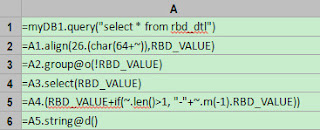The RBP_VALUE field in the rbd_dtl table stores the string “all”
and some letters. We want to convert values in the field to strings of segments.
The desired result is A-F,H,J-K,N-O,Q-S,U-V,X-Z.
Below is the original data:
Rules to
be followed are:
If RBD_VALUE= “ALL”, then discard the
value;
According to the alphabetical order if
certain RBD_VALUE values are consecutive letters , then make them a segment
with both the first and last letter included and “-” between them, like “A-F”;
If two values of RBD_VALUE are
inconsecutive, like K and N between which L and M are absent, then unite the
former with the letter or letters before it and join the latter with the letter
or letters after it. Separate the two segments with a comma. This is like “J-K”,
“N-O”;
If a value in RBD_VALUE has not consecutive
letters both before and after it, then take it as a separate segment, like the
letter H. G and I are absent respectively before and after it.
A1: Execute the SQL statement.
A3: Group rows in A2. Group rows where RBD_VALUE is null together and put the other rows where RBD_VALUE is non-null into another group. @o means performing merge-style data grouping, which only compares the neighboring values. The result is as follows:
A4: Select
the group in which RBD_VALUE is non-null.
A5: Compose strings according to the number of members in each group. ~.m(-1) means getting the last record from the current group. The result is as follows:
A6:With commas being
delimiters, concatenate strings to get the final result A-F,H,J-K,N-O,Q-S,U-V,X-Z.
Actually
we simply need to retrieve data from RBD_VALUE field. Thus the lines of code
can be combined into one:
myDB1.query("select
RBD_VALUE from rbd_dtl").(RBD_VALUE).align(26.(char(64+~))).group@o(!~).select(~(1)).(~(1)+if(~.len()>1,"-"+~.m(-1))).string@d()






No comments:
Post a Comment